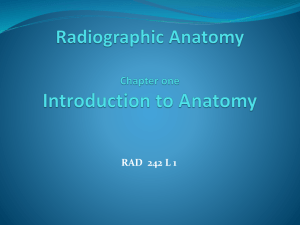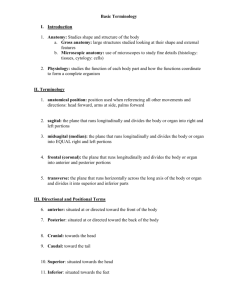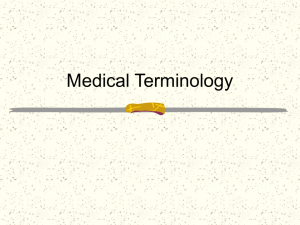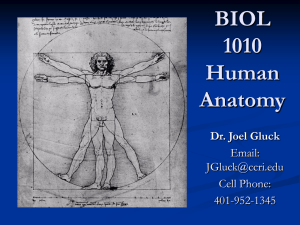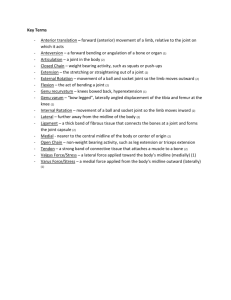Basic Terms
advertisement
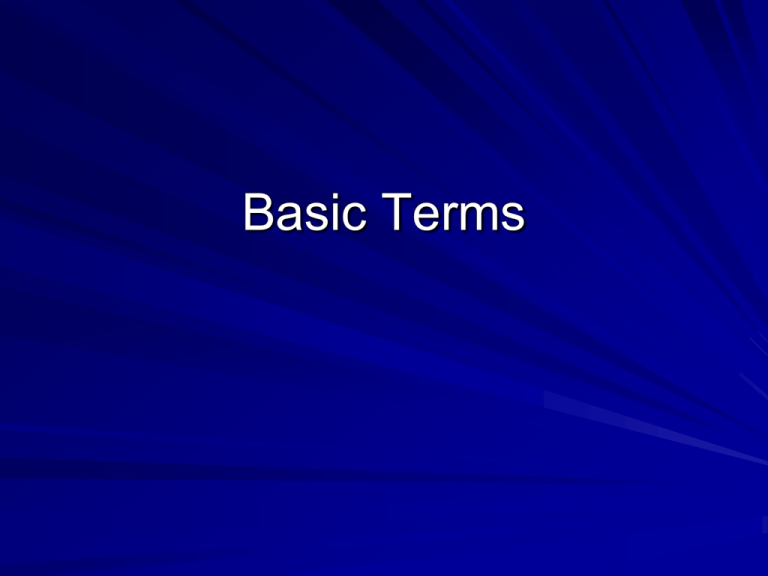
Basic Terms Anatomy Studies shape and structure of the body Gross anatomy: large structures studied looking at their shape, external features, and main divisions Microscopic anatomy: use of microscopes to study minute details – Cytology: cells – Histology: tissues and organs Developmental anatomy: growth and development – Embryology: from fertilized egg to birth Comparative anatomy: comparing human anatomy to other organisms Systemic anatomy: study of the anatomy of a specific organ system – Dermatology: integumentary system – Endocrinology: endocrine system – Neurology: nervous system Physiology Studies the function of each body part and how the functions coordinate to form a complete organism Terminology Anatomical position: standing erect, with face forward, arms at the side and palms forward Planes imaginary anatomical dividing lines Sagittal plane: divides the body into right and left parts – Midsagittal (median) plane: divided the body in to equal right and left halves Frontal (coronal) plane: divides the body into a front (anterior) and back (posterior) section Transverse plane: horizontal plane that divides the body into a top (superior) and a bottom (inferior) section. Directional/Positional Terms Anterior & Posterior – Anterior: towards the front of the body or structure – Posterior: towards the back of the body or structure Cranial and caudal –Cranial: towards the head –Caudal: towards the tail Superior and inferior –Superior: towards the upper part or “above another” –Inferior: towards the lower or “below another Medial and Lateral –Medial: toward the midline or the median plane –Lateral: away from the midline or median plane –Bilateral: having or pertaining to two sides Proximal and distal –Proximal: toward the point of attachment of the body – closer to the root of the structure –Distal: away from the point of attachment to the body – away from the root of the structure ** These terms are only used when talking about extremities (arms, legs, fingers and toes) Superficial and Deep –Superficial: on or near the surface of the body –Deep: away from the surface of the body Terms of Basic Anatomy Ligament: band of tough connective tissue that connects bone to bone Tendon: fibrous cord of connective tissue cotinuous with the fibers of a muscle; connects muscle to bone Joint: the junction or union between two or more bones Cartilage: the gristle or white elastic substance attached to articular bone surfaces and forming parts of the skeleton Bone: the hard, tough, elastic material that forms the skeleton; composed primarily of calcium salts Muscle: type of tissue containing fibers that contract; when working together they can move a body part or organ Fascia: band of sheath of connective tissue that encases muscle or tendon Bursa: a sack or sack-like cavity in the vicinity of a joint which acts to reduce the friction around a joint Extremity: a limb or appendage Terms of Movement Range of Motion: the amount of normal movement of a particular joint Abduction: to move away from the center or midline Adduction: to move towards the center or midline Flexion: to decrease the angle of a joint: to bend a limb Extension: to increase the angle of a joint: to straighten a limb Rotation: to move a limb around a joint axis Circumduction: to move a joint in a circle Plantarflexion: to point the toes/foot down – stand on your tip toes Dorsiflexion: to pull the toes/foot up Inversion: to rotate the foot so that the sole of the foot is facing in Eversion: to rotate the foot so that the sole of the foot is facing out Pronation: to rotate the palms/forearm so that they are facing posteriorly (when body is in anatomical position) Supination: to rotate the palms/forearm so that they are facing anteriorly (when the body is in anatomical position Valgus: force directed towards the midline of the body Varus: force directed away from the midline of the body Injury terms Acute and Chronic –Acute: having a sudden onset and short duration (sprained ankle) –Chronic: having a gradual onset and long duration (shin splints) –Sprain: injury to a ligament –Strain: injury to a muscle or tendon Sign: objective evidence of an abnormal situation in the body Symptom: subjective evidence of an abnormal situation in the body
